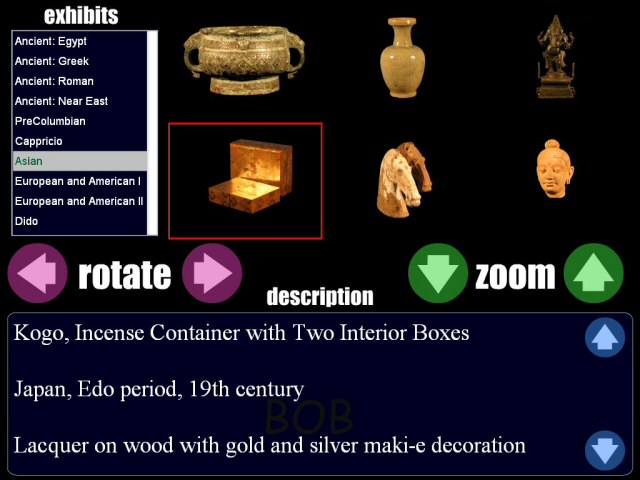The Gallery of Art and Technology is a permanent installation at the University of Missouri – Columbia Museum of Art and Archaeology, created by the Computer Human Interaction Laboratory under the direction of Prof. Ali Hussam.

It features five kiosks running various exhibits, including:
- Lewis and Clark Adventure (Nathan Bleigh and Zach Fischer)
- Harriet Tubman Educational Game (Justin Satterley)
- Virtual Exhibits (Michael Noland)
- 1804 St. Louis (Sunny Chauhan, Eli Kerry, Michael Noland, Remy Nsengiyumva, Tyler Robertson)
- Women in History: Josephine Baker Game (?)
- Interactive Painting: Architectural Capriccio (Zach Fischer)
- Interactive Painting: Dido in Resolve (Nathan Bleigh)
There was also a news story about the exhibits published in the Columbia Missourian.
1804 St. Louis
We constructed a virtual environment modeled on downtown St. Louis in 1804, reconstructed from materials provided by the museum. It includes a number of informative signposts and audio cues throughout downtown St. Louis in 1804, as well as special cue points. At each special point, the user can press a button to view modern St. Louis through a 3D panorama. I did troubleshooting and debugging on the project, as well as taking pictures on-site in St. Louis.
Virutal Exhibits
Many museums have far more artifacts than space to display them in; in this case, more are in storage than on display. To solve this problem, Adel Al-Fayez built a scanning device to digitize the artifacts and I built the virtual display case to show them. There are six screens to display individual artifacts on, and a touch screen to control the exhibit. An object can be selected and rotated or zoomed on the touch screen, or via an attached spin-wheel on the side of the pedestal. Whenever a new object is selected, a description of the object (as would be displayed on a placard in a real display case) appears on the screen. A different ‘gallery’ of six objects can be selected at any time from the list on the touch screen.
Adding new artifacts to the kiosk does require some technical expertise due to the digitizing steps (image capture is fully automatic, but removing outliers is a manual process), but once the object has been produced, it can be added to the display either via a small tool or by copy-pasting a template in the XML database and filling in the name, description, and object URL.
This was my project, from concept to finish, I did all of the specification, programming, and testing.


In addition to work on the individual projects, I was responsible for the specification, ordering, and wiring of all of the kiosk controls. I also created the wrapper program to display the interactive paintings used for the gallery opening, and a VR goggles based panorama viewer (cut from the exhibit as our magnetic tracker died).